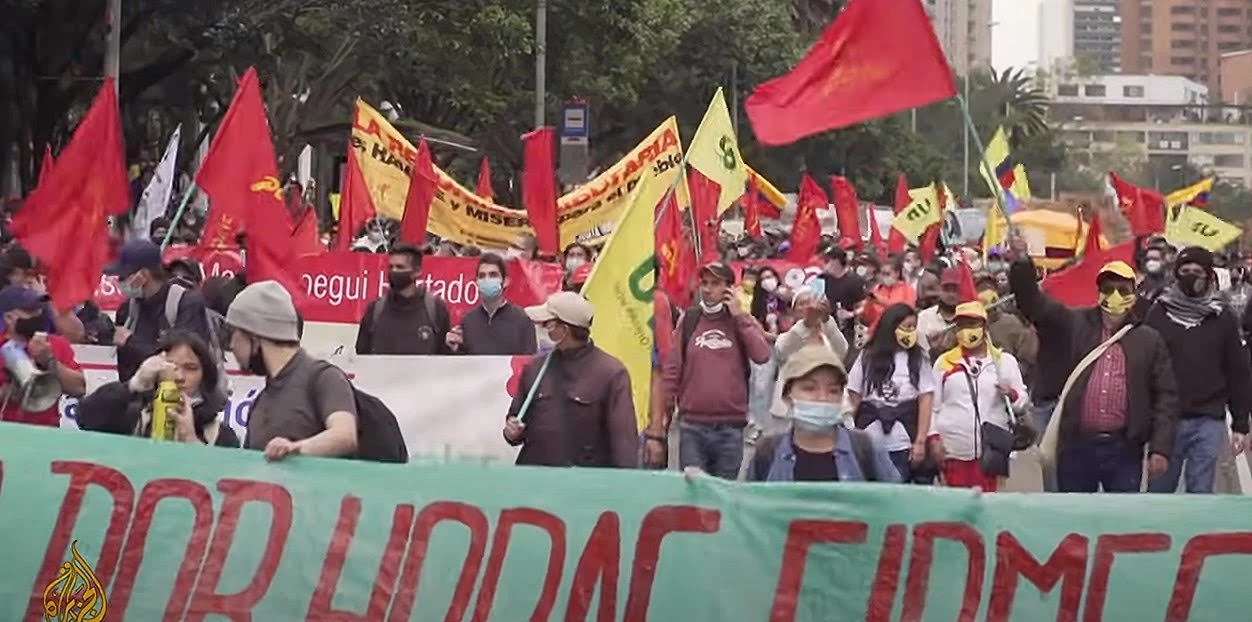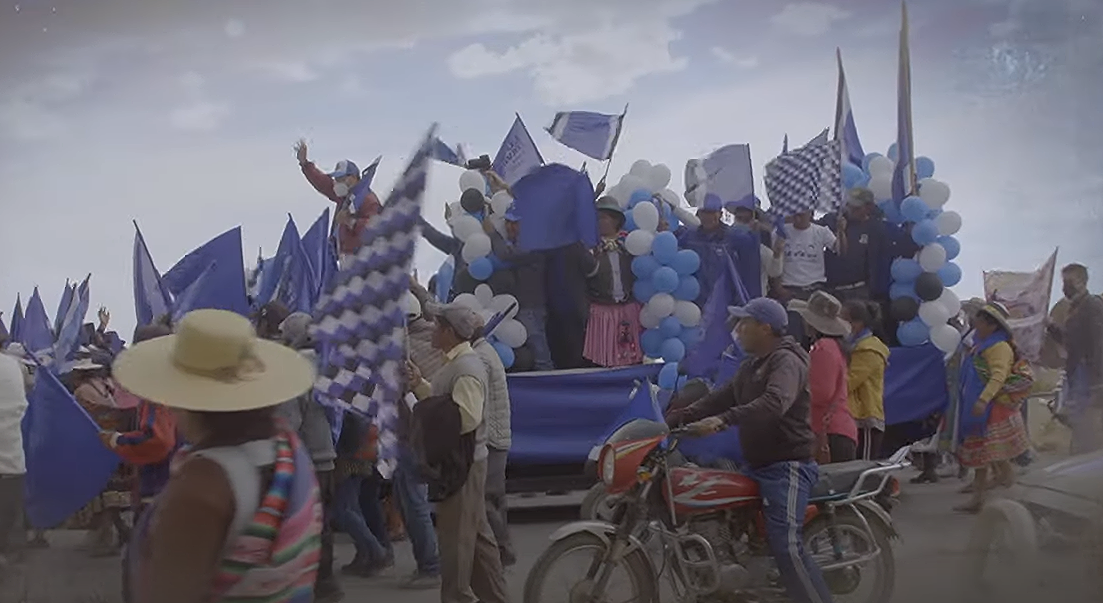
A new mood of rebellion is haunting Latin America and in country after country the fight for democracy and against austerity is centre-stage. Popular mobilisation has been fuelled by outrage at the corruption of right-wing governments and their wilful incompetence in dealing with the coronavirus pandemic, which has hit the continent particularly hard. The rebellion is being led by young people, indigenous people, workers, and youth.
The Colombian uprising
In Colombia, a massive, semi-insurrectional movement started at the end of April as hundreds of thousands throughout the country mobilised against a tax reform that transferred money to the rich, imposed by the hard-right government of Iván Duque Márquez. On 28 April, a national strike took place and amid mass mobilisations of insurrectional proportions. As one account puts it:
Mass mobilisations were unleashed all over the country, including in the medium-sized cities, and they brought together not only formal workers, but also informal workers, unemployed youth, women’s, and neighbourhood organisations. The government responded to this with the same recourse as always: savage violence against the people.[1]
Despite the standard response – huge and murderous repression – the government also withdrew the tax reform, while at the same time claiming that ‘criminal gangs’ had caused the violence.
The savage violence resulted in 37 deaths on demonstrations and more than 100 leaders of the movement ‘disappeared’ by a state apparatus that for decades, in alliance with right-wing and criminal death-squads, has waged war on anyone contesting its rule.
The 28 April strike closed down the country and was accompanied by huge street protests and blockades in major cities like Bogotá, Medellán, and Cali. The strike was called by a National Strike Committee made up of the central trade unions (CUT, CGT, CTC) and the teachers’ union Fecode. But NGOs and local people reported that the unions were pushed into action by the mass mobilisation of people outside the union structures.
The breadth of the mobilisation has taken the Colombian elite and right-wing commentators by surprise. They had thought that the complete demobilisation of the FARC[2] guerrillas in 2017 marked an end to significant rebellion in the country. Now it has re-emerged in a spectacular fashion.

The militancy and determination of the protestors reflects the poverty and hardship caused by massive inequality and the elite’s irresponsibility in the face of the pandemic, which has caused 80,000 deaths officially, but probably many more in reality.
Across the continent, the 2008 financial crash undermined the tax revenues of the left-wing governments of the so-called ‘pink tide’ (Brazil, Bolivia, Ecuador, and Venezuela) and they were either driven from office or, in the case of Venezuela, placed under siege by the authoritarian right. Now the Left is back, buoyed by popular outrage at the performance of right-wing leaders during the pandemic.
The Chilean referendum
Prior to the Colombian revolt were many other signs of a new mood of resistance. Last November, in Chile, a referendum recorded a huge defeat for the old constitution imposed by the semi-fascist military dictatorship of Augusto Pinochet in the nightmare years after the 1973 coup. More than 78% voted against the old constitution, which imposed privatisation – for example, of health services, social care, and education – by law.
The referendum’s repudiation of neoliberalism did not come out of the blue, but was the result of repeated mobilisations, particularly of youth and students, which started with the so-called ‘Penguin Revolution’ in 2006. A series of strikes of high-school and university students, demanding free access to education, took place between 2010 and 2014.
The student movement woke up popular revolt again in 2019, starting with protests against transport fare hikes and over market-oriented education. According to Al-Jazeera:
Secondary students kicked off more than a month of non-stop nationwide demonstrations when they organised mass fare evasion protests in Santiago against a now-lifted subway fare rise. Protests almost immediately broadened into demonstrations over long-simmering grievances, including growing inequality and the dictatorship-era constitution.[3]
As usual, the movement was met with vicious repression, with 26 people killed in street battles. But the movement was unbowed:
In spite of the clampdown, daily marches, rallies, occupations, street barricades, citizen assemblies, and other actions continue. Police often crack down with tear-gas and force regardless of whether people are in joyous mass rallies, small groups fighting back with rocks, or simply bystanders in the area.[4]
But the Right is fighting back against their referendum defeat. A key factor will be the composition of the assembly charged with rewriting the constitution, which is being elected on 12-15 May.
The Bolivian revolt
At the same time as the political turmoil in Chile, Bolivian politics has been turned upside down. In 2019, left-of-centre president Evo Morales was forced out in a political coup backed by the military, after the Right claimed he had been re-elected in presidential elections by fraud. He went into exile, first in Mexico, then in Argentina. In last November’s re-run elections, Luis Arce, the candidate of Morales’ Party, the Movement Towards Socialism (MAS), won a landslide victory. Evo Morales immediately crossed the border from Argentina and returned to his original political base in Chimore in Cochabamba province.

One thing that is obvious about the MAS is that its conception of moving towards socialism is an extremely slow one. Morales’ government carried out pro-working class reforms, but key extractive industries remained in private hands. Luis Arce wants to distance himself from Morales and pursue a more ‘moderate’ course, despite Morales remaining president of the MAS. Arce claims he will govern for ‘all Bolivians’, i.e. for the rich as well as the poor.
Evo Morales may have protected the basic structures of Bolivian capitalism, but his pro-working class reforms – taking mining companies and other sections of the rich to fund social welfare – were too much for the Bolivian capitalist class, who despised the country’s first indigenous president.
The scene is set for sharp tensions inside the MAS, and new mobilisations of workers and indigenous people. These will take place in a framework of the re-assertion of democratic choice at the ballot box.
The Argentine feminist movement
A major new victory for popular mobilisation was December’s decision by the Argentine Senate to legalise abortion in certain circumstances. This is far from total victory for reproductive rights, granting only the right to abortion up to 14 weeks, and individual doctors will have the right to opt out. But it is a major victory for women in Argentina, and especially for the poor, among whom unsafe and dangerous illegal abortions were most widespread.
The victory on this issue, in a country where the Roman Catholic Church is still very strong, is the product of decades of struggle. It is particularly the result of the consolidation of what many observers say is the biggest feminist movement in the world, itself a result of a mass upsurge against femicide in 2016. This movement continues as the femicide crisis rolls on.
The Ecuadorian and Peruvian anti-austerity movements
The struggle in Ecuador, like that in Peru, is essentially a fightback against austerity led by people from indigenous communities.
In Ecuador, the government of the inaptly named Lenin Moreno, which came to power in 2017 after the ten-year rule of ‘pink tide’ president Rafael Correa, turned the country sharply rightwards with pro-neoliberal reforms. In November 2019, a big increase in fuel prices led to an eruption of struggle, led by the indigenous movement. The problem has been translating popular revolt into electoral victory for the Left. Regrettably, the second round of the presidential elections on 11 April resulted in victory for the hard-right neoliberal candidate Guillermo Lasso, mainly because of divisions on the Left. In a run-off between Lasso and centre-left candidate Andrés Arauz, the highly influential indigenous alliance CONAIE called for abstention, as did previous moderate-left president Rafael Correa. With 16% abstentions on election day, the path to victory for the Right was opened. The 2017 uprising in Peru has been followed by a major new wave of struggle, starting in November last year when two governments fell in the course of a single week. Behind these eruptions of struggle is the country’s appalling record in the Covid-19 crisis, widespread corruption, and all the usual plagues of Latin America – poverty, precarious labour, lack of healthcare, and a zero future for young people. In turn, much of this reflects the low prices paid by international corporations for the country’s key export, copper. In December 2020, a national strike of agricultural labourers led to the repeal of a proposed new agricultural law that would have allowed agribusiness corporations to restrict workers’ benefits like holiday pay. The strike was symbolic of the new mood.
The Brazilian disaster In terms of population and economic clout, the giant of Latin America is Brazil. The 2018 election of extreme-right politician Jair Bolsonaro was a major blow to the working class and the Left in the whole continent. The dire consequences of his election have been symbolised by his dismissal of the coronavirus as ‘a little flu’ and his refusal of lockdowns and other measures to alleviate the pandemic. The result has been 360,000 deaths, as the virus spreads like wildfire through the poor shanty-town favelas and among workers packed into the crowded transport systems of Sao Paulo and other major cities. As a consequence, Brazil has become, according to Professor Miguel Nicholelis, the ‘brewing ground’ for new variants of Covid-19 and maybe even completely new viruses. Bolsonaro is facing growing resistance. On 29 March, he suddenly fired his defence minister, and the next day, the chiefs of all three services – army, navy, and air force – quit in protest. This internal crisis reflects widespread disaffection in business circles. The reality of life for millions of the poor in the shanty-towns was tragically demonstrated on 6 May by the militarised police incursion into the Jacarezinho favela in Rio, allegedly against drugs gangs, but in which at least 28 local people were killed. The raid, like numerous previous raids, and the Bolsonaro response to the pandemic, demonstrates the utter contempt of the Brazilian rich and their repressive state apparatus for the situation of the poor. According to opinion polls, Bolsonaro’s popularity has been collapsing. But the problem for the working class and popular movements in Brazil is the extent of the defeat inflicted by the failure of successive Workers Party (PT) governments to carry through the find of radical social reform that would have transformed the basic structures of exploitation and poverty. Although the PT government was defeated through a series of parliamentary and judicial coups, the popular movements were too traumatised and demoralised to fight back. The election of Bolsonaro was the result.
Part 2 of this article, on Venezuela and Haiti, will be published soon. Phil Hearse is a member of Anti*Capitalist Resistance and joint author of both Creeping Fascism and System Crash.
[1] https://internationalviewpoint.org/spip.php?article7131 [2] Revolutionary Armed Forces of Colombia, a guerrilla organisation which waged war against successive regimes since 1964. Inspired by Marxism-Leninism, the organisation was highly authoritarian and frequently repressed popular organisations and leaders outside its control. [3] https://www.aljazeera.com/features/2019/11/29/chile-protests-the-students-woke-us-up [4] ibid

